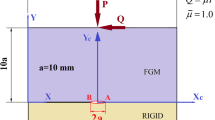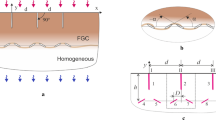Abstract
In this paper the plane thermo-mechanical behavior of a crack in a viscoelastic functionally graded materials (FGMs) coating with arbitrary material properties bonded to a homogeneous substrate is studied. In order to avoid the complex forms that describe the viscoelastic properties of FGMs, a multi-layered model for the FGMs coating is developed. The compliance and thermal conductivity in the multi-layered model linearly vary in each layer. In this mixed boundary value problem, the system is reduced to singular integral equations and solved numerically with the Lobatto-Chebyshev collocation technique. Using the correspondence principle and Laplace transform, the problem of an interface crack between a homogeneous substrate and a viscoelastic FGMs is solved. Some numerical examples are given to demonstrate the accuracy, efficiency and versatility of the multi-layered model. The numerical results confirm that the fracture toughness of materials can be greatly improved by the graded variation of material parameters. It is also confirmed that the specific variation of material parameters greatly influences the fracture behavior of viscoelastic FGMs coating.
Similar content being viewed by others
Abbreviations
- a(y, t), b(y, t):
-
Compliances of FGM
- c :
-
Crack length
- e ij :
-
Deviator components of strains
- E(x, t):
-
Relaxation function in extension
- E h :
-
Young’s modulus of the FGMs coating at y = h
- E 0 :
-
Young’s modulus of the homogeneous substrate
- Ei(t):
-
Exponential integral function
- F :
-
Airy stress function
- h :
-
Thickness of the FGM coating
- i :
-
The imaginary unit
- j :
-
Layer No.
- G1(X, t), G2(X, t):
-
Relaxation functions
- L :
-
Number of layers
- k(y, t):
-
Thermal conductivity of FGM
- \({K_{\rm I}^\pm, K_\Pi^\pm}\) :
-
Mode I and II stress intensity factor
- p :
-
Laplace transform variable
- Q 0 :
-
Heat flux at y = h
- s ij :
-
Deviator components of stresses
- s :
-
Fourier variable
- T(x, t):
-
Temperature
- t :
-
Time
- u x , u y :
-
Displacement components
- x, y:
-
Cartesian coordinates
- δ ij :
-
Kronecker delta
- δ(s):
-
Delta function
- ν :
-
Possion’s ratio
- α(y, t):
-
Thermal expansion coefficient of the FGM coating
- α h :
-
Thermal expansion coefficient of the FGMs coating at y = h
- α 0 :
-
Thermal expansion coefficient of the homogeneous substrate
- σ xx , σ yy , σ xy :
-
Stress components
- \({\varepsilon_{ij}}\) :
-
Strain tensors
- β j , γ j :
-
The linear graded parameters in the jth layer
- \({\varphi}\) :
-
Relaxation function related to the thermal expansion coefficient
- χ :
-
Real constant
References
Cheng ZQ, Zhong Z (2007) Analysis of a moving crack in a functionally graded strip between two homogeneous layers. Int J Mech Sci 49: 1038–1046
Christensen RM (1971) Theory of viscoelasticity. Academic Press, New York
Craster RV, Atkinson C (1994) Mixed boundary value problems in non-homogeneous elastic materials. Q J Math 47: 183–206
Delale F, Erdogan F (1988) On the mechanical modeling of the interfacial region in bonded half-planes. ASME J Appl Mech 55: 317–324
El-borgi S, Erdogan F, Ben Hatira F (2004) Stress intensity factors for a interface crack between a functionally graded coating and a homogeneous substrate. Int J Fract 123: 139–162
Eischen JW (1987) Fracture of nonhomogeneous material. Int J Frac 34: 3–22
Erdogan F, Gupta GD (1972) On the numerical solution of singular integral equations. Q J Appl Math 29: 525–534
Herrmann JM, Schovanec L (1990) Quasi-static mode III fracture in a nonhomogeneous viscoelastic body. Acta Mech 85: 235–249
Herrmann JM, Schovanec L (1994) Dynamic steady-state mode III fracture in a nonhomogeneous viscoelastic body. Acta Mech 106: 41–54
Jiang LY, Wang XD (2002) On the dynamic crack propagation on interphase with spatially varying elastic properties under inplane loading. Int J Frac 114: 225–244
Jin ZH, Noda N (1993) An internal crack parallel to the boundary of a nonhomogeneous half plane under thermal loading. Int J Eng Sci 31: 793–806
Jin ZH, Node N (1994) Crack tip singular fields in nonhomogeneous materials. ASME J Appl Mech 61: 738–740
Li CY, Weng GJ (2002) Antiplane crack problem in functionally graded piezoelectric materials. J Appl Mech 69: 481–488
Marur PR, Tippur HV (2000) Dynamic response of biomaterial and graded interface cracks under impact loading. Int J Frac 103: 95–109
Meguid SA, Wang XD, Jiang LY (2002) On the dynamic propagation of a finite crack in functionally graded materials. Eng Frac Mech 69: 1753–1768
Parameswaran V, Shukla A (1998) Dynamic fracture of a functionally gradient material having discrete property variation. J Mater Sci 33: 3303–3311
Paulino GH, Jin ZH (2001) Correspondence principle in viscoelastic functionally graded materials. ASME J Appl Mech 68: 129–132
Reddy JN, Cheng ZQ (2001) Three-dimensional solution of smart functionally graded plates. J Appl Mech 68: 234–241
Schovanec L, Walton JR (1987) The quasi-static propagation of a plane strain crack in a power-law inhomogeneous linearly viscoelastic body. Acta Mech 67: 61–77
Shbeeb NI, Binienda WK (1999) Analysis of an interface crack for a functionally graded strip sandwiched between two homogeneous layers of finite thickness. Eng Frac Mech 64: 693–720
Sladek J, Sladek V, Zhang Ch, Schanz M (2006) Meshless local Petrov-Galerkin method for continuously nonhomogeneous linear viscoelastic solids. Comput Mech 37: 279–289
Wang BL, Mai YW, Noda N (2002) Fracture mechanics analysis model for FGM with arbitrary distributed properties. Int J Frac 116: 161–177
Wang YS, Gross D (2004) On the mechanical modeling of functionally graded interfacial zone with a Griffith crack: plane deformation. Int J Frac 125: 189–205
Zhong Z, Cheng ZQ (2008) Fracture analysis of a functionally graded strip with arbitrary distributed material properties. Int J Solids Struct 45: 3711–3725
Author information
Authors and Affiliations
Corresponding author
Rights and permissions
About this article
Cite this article
Cheng, Z.Q., Meguid, S.A. & Zhong, Z. Thermo-mechanical behavior of a viscoelastic FGMs coating containing an interface crack. Int J Fract 164, 15–29 (2010). https://doi.org/10.1007/s10704-010-9452-2
Received:
Accepted:
Published:
Issue Date:
DOI: https://doi.org/10.1007/s10704-010-9452-2




